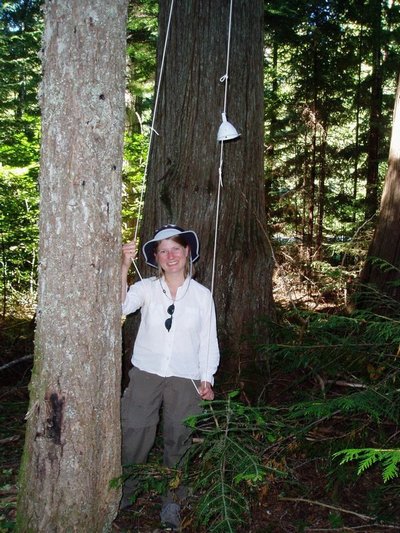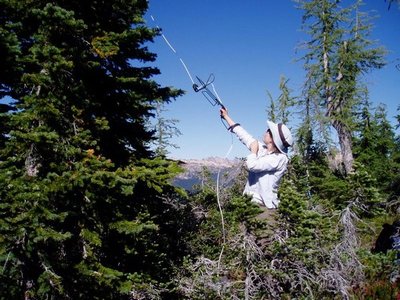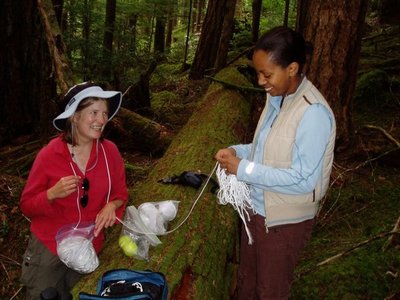December 14, 2009
Low-cost temperature sensors, tennis balls to monitor mountain snowpack
Fictional secret agent Angus MacGyver knew that tough situations demand ingenuity. Jessica Lundquist takes a similar approach to studying snowfall. The University of Washington assistant professor of civil and environmental engineering uses dime-sized temperature sensors, first developed for the refrigerated food industry, and tennis balls. In summer months she attaches the sensors to tennis balls that are weighted with gravel, and uses a dog-ball launcher to propel the devices high into alpine trees where they will record winter temperatures.
This isn’t TV spy work — it’s science. Lundquist studies mountain precipitation to learn how changes in snowfall and snowmelt will affect the communities and environments at lower elevations. If the air temperature is above 32 degrees Fahrenheit the precipitation will fall as rain, but if it’s below freezing, it will be snow.
“It’s fun, like backyard science,” Lundquist said of her sensors, which were originally designed to record temperature of frozen foods in transit. She began adapting the devices for environmental science while a postdoctoral researcher in Colorado and has refined them over the years. “It turns out they work phenomenally well.”
Last year the American Geophysical Union awarded Lundquist its Cryosphere Young Investigators Award for her fieldwork. This week at the AGU’s fall meeting in San Francisco she will present her low-cost temperature-sensing technology and some current applications.
Scientific weather stations typically cost about $10,000. Lundquist’s system measures and records the temperature every hour for up to 11 months in remote locations for just $30 apiece. Another advantage is that they are easily deployed in rough terrain.
Her temperature sensors are a fun approach to studying a serious problem. One quarter of the Earth’s continents have mountainous terrain, Lundquist said, and mountain rivers provide water for 40 percent of the world’s population. Those mountain rivers are largely fed by snowmelt. But if winters become warmer due to climate change, the snow line is expected to inch up the mountainside, and snow is expected to melt earlier in the springtime.
“Mountains are the water towers of the world,” Lundquist said. “We essentially use the snow as an extra reservoir. And you want that reservoir to hold the snow for as long as possible.”
Her sensors are being used to improve computer models in areas where water managers want to know exactly where snow is accumulating and on what date it starts to melt.
“People typically assume that temperature decreases with elevation,” Lundquist says. But actual mountain temperatures depend on the vegetation, slope and variable weather. “If you have a management decision, there’s a specific place you have to make a decision for.”
If more rain falls instead of snow, it will increase the risk of flooding during storms. Lundquist’s sensors are currently being used by the California-Nevada River Forecasting Center as part of a project pinpointing at what elevation snow turns to rain, to improve storm flooding forecasts. As part of that project, UW graduate students are placing her sensors in river canyons that are too steep for traditional weather stations.
She is also deploying sensors in Yosemite National Park to see if earlier snowmelt may cause earlier drying of streambeds and affect vegetation growth in the Tuolumne Meadows. Her sensors there provide ground verification of satellite measurements.
The City of Seattle is also using Lundquist’s sensors to study how different restoration approaches for trees in the Cedar River watershed, which supplies water to the city, affect snow retention.
“I have a lot of fun deploying my sensors because I love being in the mountains,” Lundquist said. “They also sense conditions in these remote environments that we can’t know about any other way.”
###
For more information, contact Lundquist at jdlund@uw.edu or 206-685-7594. She will be at the AGU until Thursday and will be checking e-mail once a day.
Lundquist’s Web page is at http://faculty.washington.edu/jdlund/.





